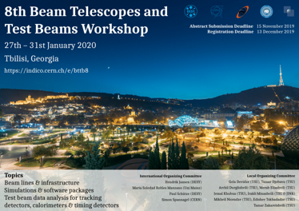Speaker
Description
A muon collider could provide scattering at the multi-TeV centre of mass energy characteristic of a hadron-hadron machine in the clean experimental environment typical of an electron-positron one, allowing for a consolidation of the present knowledge of the Standard Model and for the search of new physics. The Low EMittance Muon Accelerator (LEMMA) scheme has been recently proposed: low emittance muon and antimuon beams are produced from the collision of an about 45 GeV low emittance positron beam on a fixed target. Design studies are ongoing and it is hence important to investigate the various component starting from the muons production. The experimental characterization of the emitted muon beams from 45 GeV positron beams impinging on a fixed target is the goal of dedicated tests carried out at the CERN experimental areas H4 in 2017 and H2 in 2018. These tests were based on a silicon telescope setup complemented by a dipole magnetic field, muon chambers and a set of calorimeters to tag electrons and positrons. After a brief introduction to the LEMMA scheme, the concepts, the experimental setup and the results of the 2018 test beams are presented. In conclusion we discuss the ideas and perspectives of the next test beam at CERN in 2021.
